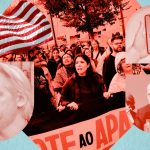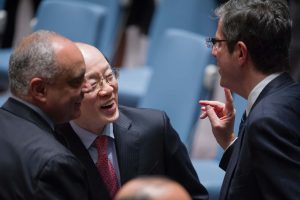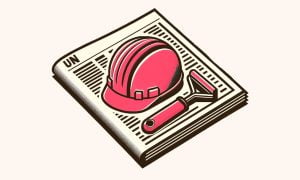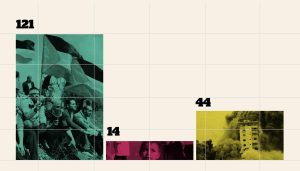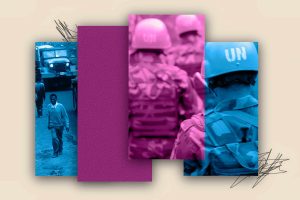The Secretariat consists of the personnel of the United Nations, with the Secretary-General as its head. It is estimated that as of 2021, more than 35,000 people are employed by the United Nations. Currently, the Secretariat consists of about 30 departments and offices. In this article, we will take a look at some of the most interesting ones (you can find a full list of them at the end of this article).
What is the purpose of the UN Secretariat?
This body of the UN is tasked with assisting and facilitating the functioning of the other principal organs. Some of its most important tasks are:
- Providing the necessary staff for all departments and offices,
- Administering the UN budget,
- Arranging the agendas,
- Preparing reports to enable discussion on agenda topics,
- Providing expert advice, and
- Supervising ongoing operations.
Apart from the Secretary-General’s office, the UN Secretariat is organised into various offices that reflect the functions and duties of the principal organs (like political affairs, disarmament…) and functional departments (like legal services, public information…).
A heads up before we start: The UN is pretty bad at choosing acronyms. Sometimes you are better off remembering the full name of the office. I shall leave the acronyms here nevertheless.
1. Executive Office of the Secretary-General (EOSG)
This is the main office of the Secretary-General. Chapter 15 of the UN Charter, describes the UN Secretary-General role as the “chief administrative officer” of the organisation, and thus tasked to carry out duties and mandates delegated to him by United Nations organs including Security Council, General Assembly, and the Economic and Social Council.
It would be highly unlikely that a genuine reformist could be appointed to the post
Article 97 in the same chapter however, makes it abundantly clear that the Secretary-General must be appointed “upon the recommendation of the Security Council” by the General Assembly, meaning that any of the 5 permanent members of the UN (US, UK, China, Russia and France) can block a nomination of the General Assembly by voting against it. Classic!
So if you have ever wondered why a particular Secretary-General’s stand on a certain topic was lamentable, it is because the Secretary-General would have had problems securing his re-election and the favour of the five gatekeepers.
The current office of the Secretary-General also includes:
- The Deputy-Secretary-General (DSG), who, amongst other things, is “responsible to assist the Secretary-General in managing the operations of the Secretariat”. This position was established in 1997 by Kofi Annan as an attempt to increase the efficiency and cohesiveness of the Executive Office of the Secretary-General.
- The special adviser on Climate Action, who is assigned to ensure the “delivery of the Secretary-General’s priorities on climate change”.
- The Assistant for Strategic Coordination, responsible for “ensuring coherence in the strategic analysis provided to the Secretary-General and conducts system-wide coordination”.
- The Senior Advisor on Policy.
- The Chief of Cabinet.
2. United Nations Office of Internal Oversight Services (OIOS)
The UN’s Office of Internal Oversight Services acts as the United Nations’ internal corruption watchdog. Internal audit, investigation, inspection, and assessment services are provided by the OIOS to assist the Secretary-General in fulfilling his supervisory responsibilities for both the organization’s resources and staff.
The OIOS was formed in 1994 at the request of the United States that the UN make efforts to reduce waste and corruption, however the effectiveness of this office has been questioned on numerous occasions.
In 2015, for example, Carman Lapointe, a Canadian who served as the head of the OIOS, was accused by Michael Stefanovic, director of the UN’s Investigations Division, of “collusion with senior officials to conduct a misguided leak investigation into a whistleblower who exposed the sexual exploitation of children by foreign troops in the Central African Republic (CAR).” Stefanovic later said Lapointe should be investigated for wrongdoing.
Although an inquiry from the UN and OIOS did name 41 peacekeepers in relation to alleged sexual abuse and exploitation, to this day, few peacekeepers have been prosecuted.
3. United Nations Office of Legal Affairs (OLA)
The United Nations Office of Legal Affairs (OLA) offers unified central legal services to UN headquarters and other UN institutions. OLA registers, publishes, and serves as a depository of international treaties in accordance with Article 102 of the UN Charter.
OLA also works towards strengthening, developing, and codifying international public and trade law, as well as those of the international legal system for the seas and oceans.
The Office of Legal Affairs also acts as the Organisation’s focal point for corporations between the United Nations and the International Criminal Court ICC. All United Nations entities can seek advice from OLA regarding matters of cooperation with any organ of the Court. All UN institutions can seek guidance from OLA in regards to cooperation with any organs of the Court.
4. United Nations Office for Disarmament Affairs (UNODA)
Established in 1998 during Kofi Annan’s incentive to reform the UN, the Office for Disarmament Affair seeks to promote nuclear disarmament and non-proliferation, as well as fostering preventive disarmament measures during conflicts, particularly those involving landmines and small weaponry.
UNODA also supports the implementation of practical disarmament measures after a conflict, such as disarming fighters and helping them to reintegrate back into the society.
In October 2020, an international treaty banning nuclear weapons was ratified by 50 countries in the General Assembly, permitting the historic text to enter reality. Although the ODA deserves credit for this, it should be noted that NONE, yes none, of the nuclear-weapon states has actually signed up to this agreement, making the treaty essentially worthless and symbolic.
The US was even reported to have written to treaty signatories saying the Trump administration believes they made “a strategic error” and urged them to “rescind their ratification”. Pathetic!
Nuclear-armed states have long argued that their arsenals intend to serve as a deterrent and that they are fully committed to the nuclear non-proliferation treaty.
The Office for Disarmament Affairs comprises of five branches:
- Conference on Disarmament Secretariat and Conference Support Branch: Based in Geneva, this branch provides organisational servicing to the Conference on Disarmament, a multilateral disarmament negotiating forum.
- Weapons of Mass Destruction Branch (WMD): Focusing on weapons of mass destruction like nuclear, chemical and biological weapons, this organ works closely with the International Atomic Energy Agency (IAEA), Organisation for the Prohibition of Chemical Weapons (OPSW) and Comprehensive Nuclear-Test-Ban Treaty Organisation CTBTO to promote the non-proliferation of WMD.
- Conventional Arms (including Practical Disarmament) Branch (CAB): Generally concentrates its work on smaller weapons that are not classified as WMD.
- The Information and Outreach Branch (IOB): Provides advisory services to states on disarmament measures
- Regional Disarmament Branch (RDB). Which acts as an information officer, updating content on the UNODA’s website and maintaining databases.
5. United Nations Office for the Coordination of Humanitarian Affairs (OCHA)
Created in 1991by the General Assembly, the OCHA is responsible for bringing humanitarian actors together for a coordinated response to emergencies and natural disasters.
You can learn more about OCHA and the services they offer by visiting their website.
6. United Nations Office of the High Representative for the Least Developed Countries, Landlocked Developing Countries and Small Island Developing States (OHRLLS)
What may seem to be a disastrous attempt at naming a UN Secretariat Office, is actually entrusted with the great responsibility of assisting 91 vulnerable Member States of the United Nations.
As the name implies these vulnerable states are categorised into three groups:
- 46 Least Developed Countries (LDCs): Consist of the world’s poorest and most vulnerable people.
- 32 Landlocked Developing Countries (LLDCs): Consist of nations who lack territorial access to the sea and due to their remoteness have significant distance from world markets.
- 38 Small Island Developing States (SIDS): A group of remote islands often suffering due to climate change.
7. United Nations Office for Outer Space Affairs (UNOOSA)
The overall objective of the UN Office for Foreign Space Affairs is to promote international cooperation and the peaceful use of outer space. The office also intends to govern the exploration and use of space for the benefit of all humanity by setting up a treaty of space law.
Who knows, maybe soon we will be able to appoint space ambassadors!
The development of a platform for space-based information systems for disaster management and creating the International Committee on Global Navigation Satellite Systems (ICG) are some other examples of their work. You can explore all the projects of UNOOSA by visiting their site.
I hope you enjoyed this piece. We will try our best to expand this piece to cover all 30 Departments and Offices of the UN. If you would like to help us with that, please contact us, we would love to hear from you.
Full list of UN Secretariat Departments and Offices
- EOSG Executive Office of the Secretary-General
- DCO Development Coordination Office
- DESA Department of Economic and Social Affairs
- DGACM Department for General Assembly and Conference Management
- DGC Department of Global Communications
- DMSPC Department of Management Strategy, Policy and Compliance
- DOS Department of Operational Support
- DPO Department of Peace Operations
- DPPA Department of Political and Peacebuilding Affairs
- DSS Department of Safety and Security
- OCHA Office for the Coordination of Humanitarian Affairs
- OCT Office of Counter-Terrorism
- ODA Office for Disarmament Affairs
- OHCHR Office of the United Nations High Commissioner for Human Rights
- OIOS Office of Internal Oversight Services
- OLA Office of Legal Affairs
- OSAA Office of the Special Adviser on Africa
- SRSG/CAAC Office of the Special Representative of the Secretary-General for Children and Armed Conflict
- SRSG/SVC Office of the Special Representative of the Secretary-General on Sexual Violence in Conflict
- SRSG/VAC Office of the Special Representative of the Secretary-General on Violence Against Children
- UNDRR United Nations Office for Disaster Risk Reduction
- UNODC United Nations Office on Drugs and Crime
- UNOG United Nations Office at Geneva
- UN-OHRLLS Office of the High Representative for the Least Developed Countries, Landlocked Developing Countries and Small Island Developing States
- UNON United Nations Office at Nairobi
- UNOP United Nations Office for Partnerships
- UNOV United Nations Office at Vienna
- The Ethics Office
- United Nations Ombudsman and Mediation Services
- The Office of Administration of Justice





